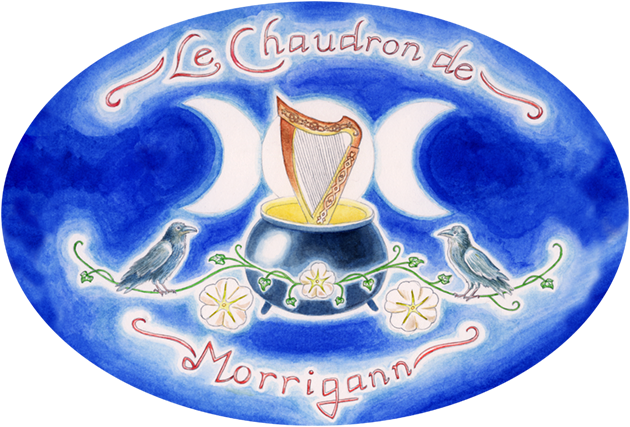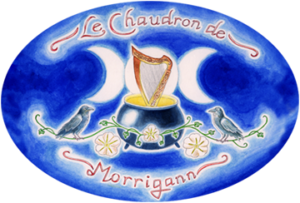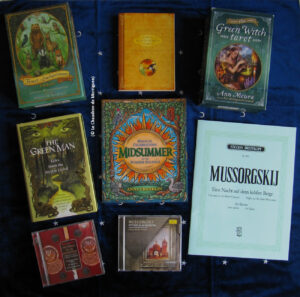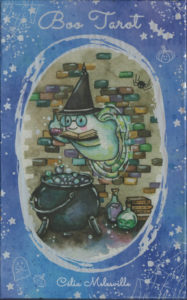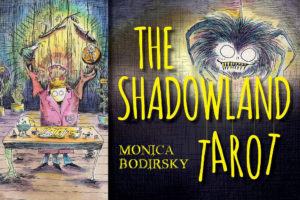Contact :
The Stolen Child Tarot (Monica Knighton): a review
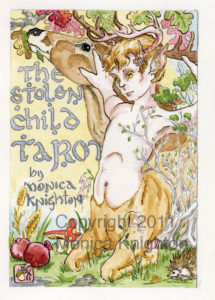 When I learnt thanks to Aeclectic Tarot that an artist was working on a tarot deck based on W.B. Yeats’ poem « The Stolen Child », I couldn’t resist looking it up… and I was immediately under the spell of the candor Monica Knighton put into her illustrations, for it is in perfect harmony with the innocence of the child on which the poem is focused.
When I learnt thanks to Aeclectic Tarot that an artist was working on a tarot deck based on W.B. Yeats’ poem « The Stolen Child », I couldn’t resist looking it up… and I was immediately under the spell of the candor Monica Knighton put into her illustrations, for it is in perfect harmony with the innocence of the child on which the poem is focused.
The Stolen Child Tarot was a self-published deck (only 500 copies) and is the result of the hard work of a talented illustrator who has a passion for tarot and faery. This deck melts tarot with the world of William Butler Yeats. In addition to being one of my favorite poets, he also was a renowned occultist and an important member of the Hermetic Order of the Golden Dawn. I had been waiting for such a deck for a long time, and Monica Knighton made my dream come true!
Presentation and packaging
As it is often the case with first versions – especially when the cards are self-published –, this deck is only composed of the major arcana. They come wrapped in two layers of green and brown cardboard tied by a thread. Those natural materials hint to the spirit of the deck since no man-made item is depicted in the illustrations. Right from the packaging, this deck seems to come straight from Faery world!
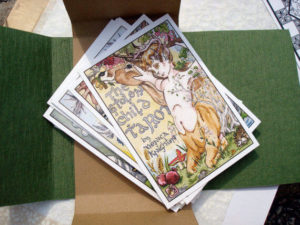
The Cards
Quality
By taking off the thread which seals this treasure chest, the twenty-two major arcana appear, as well as the card displaying the number identifying the copy of the deck you own (it is a numbered deck!). Just like the other cards, this one is wonderfully illustrated.
The cards are perfectly cut in thick white cardstock. This already shows how careful and meticulous the artist was in the production of the deck.
A beautiful rewriting of the Rider-Waite Smith Tarot
Structure and symbolism
Even though apparently loosely based on it, the deck follows the structure and symbolism of the Rider-Waite Smith Tarot. Indeed, the eye has to be sharp and attentive in order to identify the cards, but this is precisely what makes the subtlety of the illustrations and their quality, both on pictorial and divinatory levels. In fact, Monica’s paintings go deeper into the symbolic language of the Waite system than what can be seen at first.
The black and white back of the cards cleverly shows four animals. Each of them is associated with one of the four elements: a salamander stands for Fire, a squirrel for Earth, a fish for Water and a bird for Air. They appear in a diamond shape at the center of the back of the card and face their respective opposites. The squirrel is thus facing the bird, and the same thing goes for the fish and the salamander.
The way Monica Knighton composed variations on the symbolism of the Rider-Waite Smith Tarot without betraying it is remarkable. The deck takes a very unique flavor thanks to the merging of the language of the Waite tradition with the fairy world where everything takes place here. This richness can be appreciated thanks to a brief presentation of a few cards.
The Fool
The Fool depicts the young child on whom the whole deck is focused on. He is naked and sits in the green grass, bathed in the sunlight. Flowers grow around him. The child is laughing out loud surrounded by hummingbirds playing with him. Although this scene looks very different from what we are accustomed to, it pictures the very same ideas: the nudity of the child and the laughing materialize the innocence and the vulnerability that are attributed to the Fool in the Waite tradition. The beginning of the sacred cycle is also suggested by the child himself who, just as the Fool is at the beginning of his long way, is at the dawn of his own life and thus clear of any experience.
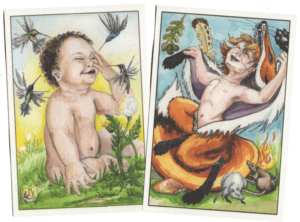
The Magician
Because of his fox disguise and of the two rats about him, the Magician is identified as cunning and clever right away. His mustaches and fangs trigger questions about his real nature: he is definitely not human and seems to have changed into a fox thanks to some magic trick. This idea is reinforced by the four elements that are represented around him: Fire (behind him), a shell for Water, an oak leaf for Earth and a feather for Air. Nature is his altar.
The High Priestess
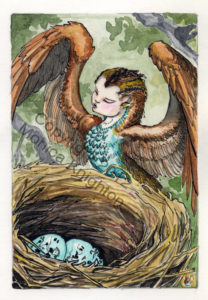 The rendition of the High Priestess may seem peculiar at first. Nevertheless, a close look at her reveals that the card shows the principles she embodies. Half-fairy half-bird, a creature stands with open wings before a nest where two eggs are lying. Interestingly enough, one can notice that the creature’s chest and the eggs are blue. This is clearly an allusion to spirituality and to the High Priestess’ mantle in the Waite tradition. Here, the eggs are the pillars of the Temple of Nature, for they embody the secrets of the making of Life and gestation in any sense. Those two aspects are connected in the sense that the egg holds the mysteries of Life to which the High Priestess has unlimited access. She thus has the sacred knowledge of the secrets of Creation.
The rendition of the High Priestess may seem peculiar at first. Nevertheless, a close look at her reveals that the card shows the principles she embodies. Half-fairy half-bird, a creature stands with open wings before a nest where two eggs are lying. Interestingly enough, one can notice that the creature’s chest and the eggs are blue. This is clearly an allusion to spirituality and to the High Priestess’ mantle in the Waite tradition. Here, the eggs are the pillars of the Temple of Nature, for they embody the secrets of the making of Life and gestation in any sense. Those two aspects are connected in the sense that the egg holds the mysteries of Life to which the High Priestess has unlimited access. She thus has the sacred knowledge of the secrets of Creation.
The Empress and the Emperor
In this deck, the Empress and the Emperor are a couple, just like in the Waite tradition. Both are bears, the one being a brown bear and the other a polar bear. As is well known, the bear is a plantigrade and thus embodies solid stability, which is precisely the dominant feature of the imperial couple in the tarot.
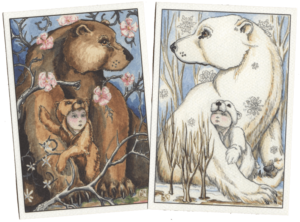
When put side by side, the two cards show stunning similarities: one bear is the reflection of the other as in a mirror, except for the front left paw which is not in the same position. On both cards, the child stands between their front paws and wears a cub skin of the same color as the bear of the card. Furthermore, the Empress remains connected with the idea of fertility through the white and pink flowers that are about her. The Emperor appears as the dominant element, not only by his bear nature which settles his extraordinary might and balance, but also by his great strength and robustness, which are suggested by the polar landscape in which he is depicted. He is surrounded by snowflakes which echo the Empress’ flowers.
The Hierophant
The Hierophant is a pelican and stands on a rock before two mermaids. Under his foot lies a fish. Showing a pelican on this card is very interesting because is emphasizes the way this animal is connected with religion. Indeed, it was long believed that pelicans tore their own chest up with their beak in order to feed their young ones, thus sacrificing in the same way Christ did to save humanity. The truth was understood much later: in fact, the bird uses his beak to fetch the food he keeps in a special pouch. He nevertheless remains a Christlike figure. He thus naturally was chosen to embody religion and dogma, in the same way as they are expressed by the Hierophant in the Waite tradition. The two mermaids are similar – in position and role – to the two monks which appear on the original card.
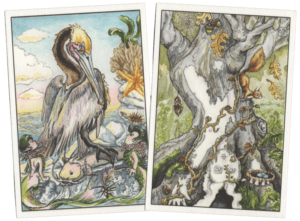
The Hanged Man
The Hanged Man is definitely one of my favorite cards. Very rich in terms of symbolism, it refers to the different aspects of the Hanged Man, both on the initiatory and on the mythological levels. As a consequence to hanging on the tree, the creature has merged with it. This is a clear reference to the sacred tree that connects the worlds and which is called Yggdrasil in Norse mythology. The squirrel that runs between the roots and the branches of the tree reminds of Ratatosk in Snorri’s Edda, for he behaves in the same way.
The spider (and its web) that hangs on the other side of the tree pictures patience, which is one of the main features of the Hanged Man in the tarot. If we take into account how much the creature has been « swallowed » by the tree, we can understand that he’s been there for some time. This idea is emphasized by the moss that grows on the roots of the tree and spreads on the character’s right arm and by the liana which runs around the trunk and depicts the bonds that prevent the Hanged Man’s movement. However, it is precisely this immobility that enables him to access sacred knowledge, which is embodied by the eggs that lie in the nest he is holding in his left hand.
Death
Death is also one of my favorite cards for the point of view adopted by Monica Knighton for her rendition of the specific symbolism is very subtle and witty. Set at night, the scene shows two animals and a fairy-child who stands under a mushroom. A raven spreads his right wing while a moth rises above that very same mushroom. The raven is usually taken as a deadly omen and connected with the darkness. The type of moth chosen here is particularly well chosen here, for it is a Death’s-head moth. This symbol of metamorphosis associated with the image of death illustrates the transformation traditionally expressed by the 13th major arcanum. The two types of toxic mushrooms that grow in the grass remind of the fact that danger is always at hand.
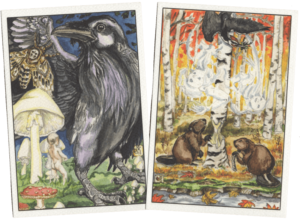
The Tower
The Tower is also a real work of art and a model of subtlety. Here, there is no building whatsoever. The Tower is a birch tree. Here, no lightning either. The fall of the tree is caused by… beavers! They weakened the tree by gnawing it, so that it is about to fall. Before it reaches the ground, two ethereal spirits escape from the tree. They echo the two figures that fall from the tower in traditional imagery. A bird also rises from the top of the tree, in the same way as the crown is severed from the top of the Tower. Moreover, the autumnal setting emphasizes the original symbolism of the card thanks to the fiery colors of the season which are in adequation with the fire that causes the Tower to fall. An interesting parallel can easily be seen between the fall/decline of the Tower and the decline announced by the season (also called fall!) which leads to winter.
These few elements give only a hint of the richness and the fineness of the whole deck. This deck is an invitation into Faery Land and gets you to wish you could go and discover the World with Fairies as your guides, just like the child who leaves the human world which is full of tears and sorrows to go towards Faery Land where carefreeness and joy govern. The tribute paid to Yeats is incredibly wonderful. Indeed, the poem can be understood on several levels for it has several meanings since it can also be read as the passage of the child from life to death because going away with fairies is the same thing as going to the Other World in Celtic mythologies and folklores. The point of view presented here by the artist plays on these several levels, making the deck even more interesting.
The little white book
As this is a self-published, there is no little white book in its usual form. A .pdf file is sent by Monica when the order is made. It contains the main meanings of the cards and a few words about their symbolism. The document does not display any special spread or reading method.
Using the deck
This deck may be used like any other Rider-Waite Smith type tarot deck [N.B.: the version presented here only has the twenty-two major arcana].
It is also an ideal tool for meditation for the cards invite you to daydreaming and to escape into Faery Land.
Further remarks
The Stolen Child Tarot is a unique deck by its originality, its accuracy and the subtlety which appears on each and every card. The profusion of details can be surprising to the eye at first, but once used to looking at the cards and to deciphering the parallels between traditional tarot imagery and that adopted by the artist, one can access a world of stunning depth. Once the specific language of these cards has been assimilated, the absence of names and numbers is not a problem anymore.
I do not wish, even for a second, I hadn’t bought this deck. It is the perfect deck for anyone who, like I do, loves Yeats’ works, faery worlds and esotericism, and who likes to keep in mind the connection that exists between the poet and esotericism, for he was indeed an important member of the Hermetic Order of the Golden Dawn and did a lot for this initiatory order. Many of his works have thus been influenced by and illustrate principles and ideas specific to the Golden Dawn. Monica Knighton pays a beautiful tribute to Yeats – both the poet and the specialist in Irish folklore – through cards which translate the very depth that can be found in his works. Needless to say, this deck has a very special place and great value in my collection since it is one of my favorites!
Who is this deck for?
The Stolen Child Tarot is for everyone who likes tarot, literature and/or art. I admit that the peculiar symbolic system that is used here can make it a bit difficult to understand for beginners, but anyone can be delighted with the way the artist depicts the World. More experienced tarot users will be impressed by the originality and the ingenuity shown by the artist to produce those beautiful cards, for they are both true works of art and very faithful to the Waite tradition.
Collectors will definitely want to add this item to their collections. Whether you want to use it for divination, meditation or to give it the status of a piece of art (or all of these all at once!), this is a invaluable deck.
If you have a taste for everything having to do with fairies, Celtic folklores and/or Yeats’ works, this is the perfect deck for you!
Where to find the deck
Unfortunately, only 500 copies of this deck were published and there is no available copy anymore. However, if – as I do – you want to see this deck completed and made into a 78 card tarot deck, you can support Monica Knighton’s project on her Kickstarter page by helping her funding the making of the deck. If the pledges reach a certain amount of money in a given time, 2000 copies of the whole deck will be self-published!
Acknowledgements
I would like to thank Monica Knighton. All the pictures of the cards in this review appear with her kind permission.
(© Morrigann Moonshadow, March 10th, 2013; trans. March 13th, 2013. Further reproduction prohibited.)
